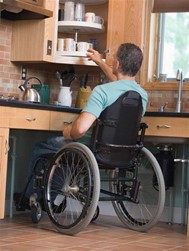A recent poll reveals that during lockdown, disabled people were 17 times more likely than non-disabled people to be unable to carry out all daily tasks and activities at home without help (35% v 2%) and more than two in five were unable to fully use their bathroom or kitchen without assistance (22% v 23%).
Almost a quarter (24%) of disabled people surveyed said they don’t have a home that meets their access needs.
This is the reality of life in lockdown – and potentially not too different from life pre-Covid-19 – for many disabled adults and older people living on their own and it’s not acceptable.
Furthermore, disabled adults were over three times more likely than non-disabled adults to report that the inaccessibility of their home undermined their wellbeing during lockdown (21% v 6%).
Let’s be mindful that accessible housing isn’t only about making it easier for disabled people to navigate their home and use their spaces and appliances.
“Many disabled people are making do without these simple features because there is such a huge shortage of accessible homes across the UK.”
Living independently, with the right adaptations which may include wetrooms, stairlifts, accessible kitchens or simply improving access to a property can seriously improve mental health and general wellbeing, allowing opportunities for work, education, socialising and developing relationships generally.
